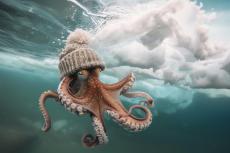A vegetarian sap-sucking sea slug that can regrow its entire body? Underwater photographer Wesley Oosthuizen takes a closer look at this curious little marine critter.
Contributed by
Autotomy, the shedding of body parts, is a well-known phenomenon in the animal kingdom. However, this does not diminish its significance as a topic of discussion. The fact is, we still have much to learn, and the scientists who uncover and share their findings on these matters deserve our admiration. Their discoveries are truly astounding and worth exploring, leaving us to ponder the potential innovations that may arise from understanding how these animals accomplish such feats.
Let’s consider the sacoglossan sap-sucking sea slug, Elysia cf. marginata. At first glance, it may appear to be a simple creature, but it is truly remarkable. While it is commonly referred to as the solar-powered nudibranch, it is more accurately labeled as the solar-powered sacoglossan. The distinction lies in the fact that nudibranchs are carnivores, while sacoglossan slugs are vegetarians. Both are sea slugs, and while using the name sea slug for either is acceptable, it is best to avoid referring to a nudibranch as a sacoglossan, and vice versa. It is similar to calling a leopard a tiger—they are both cats, but not the same species.
You might be wondering why I am highlighting this particular slug and suggesting that there is something more significant to learn about it, compared to the previous sacoglossan I wrote about in issue #116— the butterfly sacoglossan. Well, Elysia cf. marginata, also known as the “leaf slug,” operates on a completely different level from the butterfly sacoglossan. This remarkable creature has the ability to regrow its entire body even after its head has been severed. What is even more astonishing is that it can achieve this without possessing internal organs such as a heart or stomach.

Regeneration and age
A study published in the journal Current Biology reveals that the success rate of the slug’s regeneration depends on its age. Older individuals subjected to the study’s test did not survive. However, if the slug was young enough, the wound healed rapidly, and within hours, it resumed consuming algae without a heart or stomach. Within seven days, it had regrown its heart, and within 20 days, its body was fully restored.
You may wonder if the severed body had grown a new head; well, the answer is no. Nevertheless, it is remarkable to learn that the bodies themselves did not immediately die but remained active and responsive to touch. This state persisted for several days to months before the bodies started to shrink, turn pale (due to chloroplast loss), and eventually decompose. The beating heart remained visible until the body had fully decomposed.
Chloroplasts
Scientists believe that Elysia cf. marginata’s ability to regrow its entire body, even in the absence of a heart, is attributed to the presence of chloroplasts inside its body. These chloroplasts aid in regeneration and keep the slug alive despite the absence of internal organs. It is truly mind-boggling, almost like a plotline from a superhero movie—except that this is a slug, and it does not save anyone, at least not yet.
This discovery has caused a stir in the scientific community, with a general consensus that there are likely other sacoglossans capable of similar feats. In fact, another slug called Elysia atroviridis has already been found to possess this regenerative ability.
There is still much to be unveiled, and we have barely scratched the surface of what these incredible slugs can do. Only time will reveal the next wonders scientists will uncover in the fascinating world of sacoglossans. ■
SOURCES: Inverse.com, Cell.com, Wikipedia.org





























